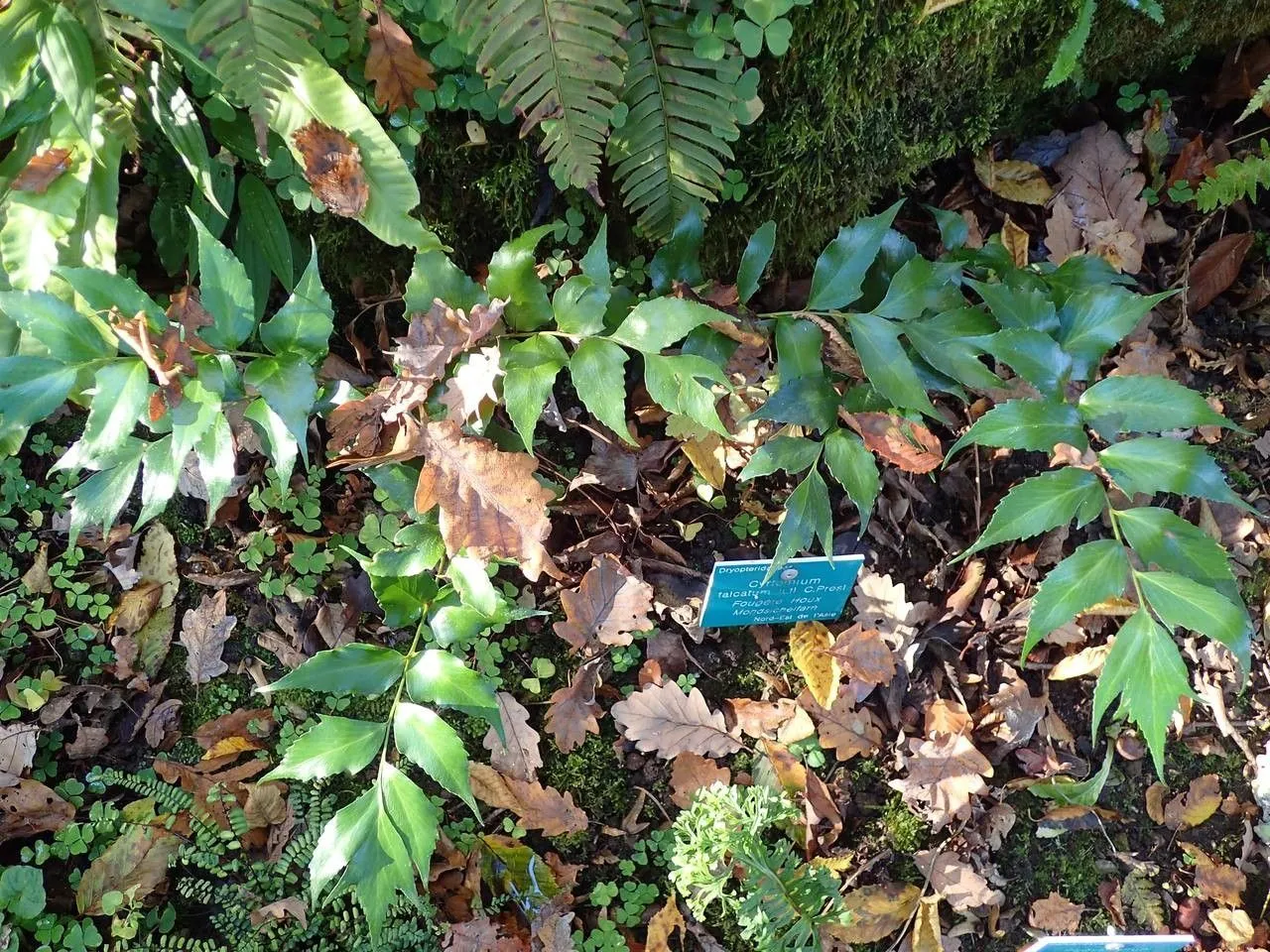
Author: (L.f.) C.Presl
Bibliography: Tent. Pterid.: 86 (1836)
Year: 1836
Status: accepted
Rank: species
Genus: Cyrtomium
Vegetable: False
Observations: China to Temp. E. Asia and Vietnam
The Japanese holly fern, scientifically known as Cyrtomium falcatum, is a fascinating and resilient plant belonging to the family Polypodiaceae. This species, described by C. Presl in the seminal work Tentamen Pteridologiae in 1836, has captivated botanists and garden enthusiasts alike with its unique characteristics and wide geographical range.
Native to regions extending from China to temperate East Asia, including Vietnam, the Japanese holly fern thrives in diverse climates and conditions. Its adaptability has allowed it to flourish not only in its native habitats but also in gardens and naturalized areas around the world.
One of the most distinctive features of Cyrtomium falcatum is its foliage. The fern sports glossy, dark green fronds that are both visually striking and robust. The fronds have a holly-like appearance, with serrated edges and an elegant, arching shape. This unique morphology not only contributes to its common name but also makes it a desirable plant for ornamental purposes in landscaped gardens and indoor settings.
In terms of care, the Japanese holly fern is relatively low-maintenance, making it an excellent choice for both novice and experienced gardeners. It prefers shaded or partially shaded environments, which mimic the dappled light conditions of its natural woodland habitat. The fern also thrives in moist, well-drained soil rich in organic matter, although it exhibits notable tolerance for a variety of soil types and moisture levels once established.
Additionally, Cyrtomium falcatum is known for its resilience against common pests and diseases, further enhancing its appeal for cultivation. Regular watering and occasional feeding with a balanced fertilizer can help maintain its lush appearance, but the fern generally requires minimal intervention to prosper.
In landscaping, the Japanese holly fern serves as an excellent ground cover or underplanting for larger trees and shrubs. Its evergreen nature ensures year-round interest, providing a consistent green backdrop that complements a wide array of flowering plants and other foliage. Indoors, it can be grown in pots or hanging baskets, bringing a touch of natural elegance to interiors.
In summary, the Japanese holly fern, Cyrtomium falcatum, is a versatile and attractive plant with a storied botanical background. Its aesthetic appeal, ease of care, and adaptability across various environments make it a valuable addition to gardens and indoor plant collections alike.
Fra: aspidie en faux, fougère-houx
Eng: house holly-fern, japanese holly fern, japanese netvein hollyfern, holly fern, house holly fern
Deu: sichel-schildfarn
Swe: mahoniabräken
Nld: ijzervaren
Nno: mahognibregne
Nob: mahognibregne
Cym: gwrychredyn-y-celyn y tŷ, gwrychredynen-y-celyn y tŷ
En: Japanese holly fern, House holly fern, Holly fern, Japanese netvein hollyfern, House Holly-fern
Zh: 全緣貫眾蕨, 全缘贯众
Nl: IJzervaren
Fi: Mahoniasanianen
Fr: Aspidie en faux, Fougère-houx
De: Sichel-Schildfarn
Ga: Ibheag dheilgneach Sheapánach
Ja: Oni-yabusotetsu
Nb: Mahognibregne
Nn: Mahognibregne
Fa: سرخس راجی خانگی
Pl: Paprotnik sierpowaty
Sv: Mahoniabräken
Zh-tw: 全緣貫眾蕨
Cy: Gwrychredynen-y-celyn y tŷ, Gwrychredyn-y-Celyn y Tŷ
© copyright of the Board of Trustees of the Royal Botanic Gardens, Kew.
© copyright of the Board of Trustees of the Royal Botanic Gardens, Kew.
© copyright of the Board of Trustees of the Royal Botanic Gardens, Kew.
Taken Oct 30, 2016 by Yoan MARTIN (cc-by-sa)
Taken Jul 23, 2021 by Manu Murray (cc-by-sa)
Taken Oct 24, 2021 by Coenie de Ruyter (cc-by-sa)
Taken Aug 31, 2019 by Pinto Pasquale (cc-by-sa)
Taken Jul 9, 2019 by Alessandra Alessandra (cc-by-sa)
Taken Feb 8, 2022 by Dieter Albrecht (cc-by-sa)
Taken Jun 10, 2013 by EOL − stelleri5 (cc-by-nc)
Taken Sep 8, 2014 by EOL − Sam Kieschnick (cc-by-nc)
Taken Oct 30, 2016 by Yoan MARTIN (cc-by-sa)
Taken May 28, 2022 by manuseitz (cc-by-sa)
Taken Feb 8, 2022 by Dieter Albrecht (cc-by-sa)
Taken May 28, 2022 by manuseitz (cc-by-sa)
Taken Jun 22, 2009 by EOL − Zoya Akulova (cc-by-nc)
Taken May 10, 2022 by Dieter Albrecht (cc-by-sa)
Taken Sep 25, 2013 by Martin Bishop (cc-by-sa)
Taken Sep 20, 2021 by Trap Hers (cc-by-sa)
Taken Sep 20, 2022 by Simon Brumby (cc-by-sa)
Taken Oct 20, 2020 by Abdullah Nuckcheddy (cc-by-sa)
Growth habit: Forb/herb
Family: Myrtaceae Author: (F.Muell.) K.D.Hill & L.A.S.Johnson Bibliography: Telopea 6: 402 (1995) Year: 1995 Status:…
Family: Rubiaceae Author: Pierre ex A.Froehner Bibliography: Notizbl. Bot. Gart. Berlin-Dahlem 1: 237 (1897) Year:…
Family: Sapindaceae Author: Koidz. Bibliography: J. Coll. Sci. Imp. Univ. Tokyo 32(1): 38 (1911) Year:…
Family: Asteraceae Author: A.Gray Bibliography: Pacif. Railr. Rep.: 107 (1857) Year: 1857 Status: accepted Rank:…
Family: Fabaceae Author: Medik. Bibliography: Vorles. Churpfälz. Phys.-Ökon. Ges. 2: 398 (1787) Year: 1787 Status:…
Family: Aspleniaceae Author: (Cav.) Alston Bibliography: Bull. Misc. Inform. Kew 1932: 309 (1932) Year: 1932…